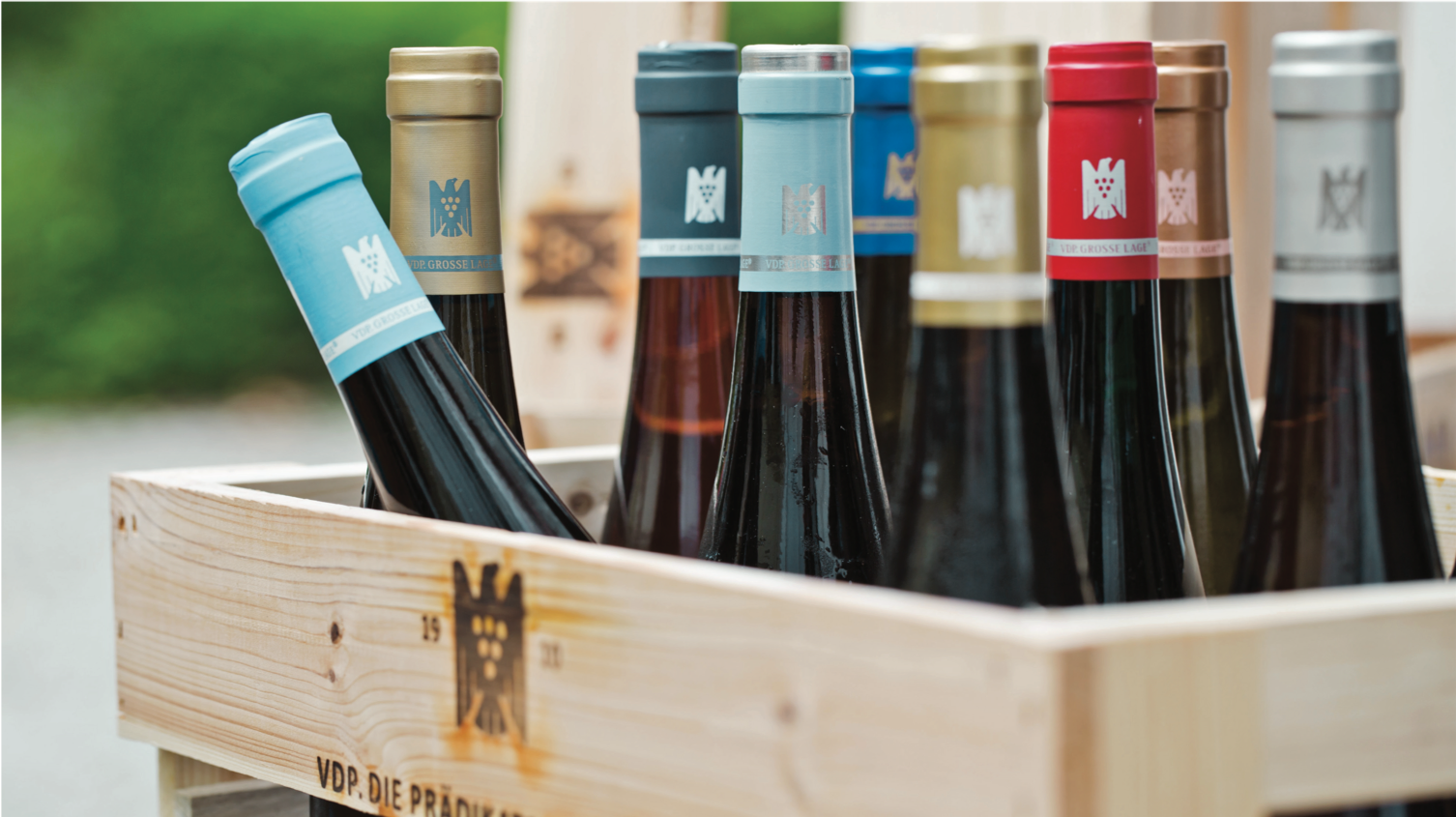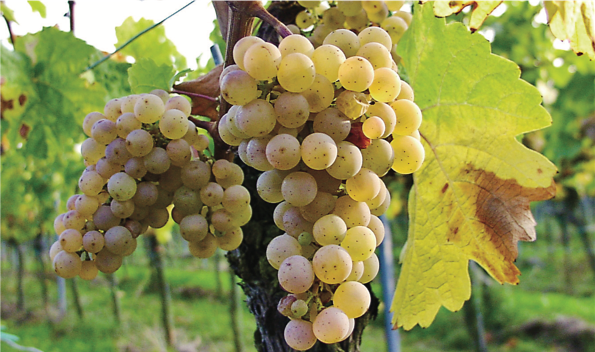by Alessandra Piubello
Centre stage in Wiesbaden for Grosses Gewächs, that is the dry version of this unique wine from the flagship Grosse Lage denomination, a gift from the south-west German soils and northern latitudes

Riesling: crystallinity, energy, purity. And also: finesse, rigour, versatility and longevity. Quintessential minerality. A unique wine, miraculously counterbalancing high acidity, low alcohol content and sugar residue. It relates the essence of a reticent grape that rebels against manipulation in the cellar.
A gift of northerly latitudes (between the 49th and 51st parallels), the diversified soils of south-west Germany, and a superb variety, the loftiest expression of the genius loci terroirista. The ‘cool’ climate (the impact of climate change is felt here, too: it is estimated that the district has warmed by one degree over the last 25 years), the arrangement of the vines, and the southerly exposure al- low the grapes to ripen very slowly so they are enriched with extracts, acidity, sugars and aromatic substances.
It is a variety (among the first to flower and usually among the last to be harvested, with the longest vegetative life of all), which precisely because of its complexity and ‘wisdom’ manifests its inimitable distinction and thrilling magic over time, with its evolution in the bottle. Inevitably, its catalysing charm brings us to the preview of the Grosses Gewächs organized by VDP in Wiesbaden. Let us immediately clarify the meaning of the acronym. The VDP (Verband Deutscher Qualitäts und Prädikatsweingüter, the German union of quality winemakers and denomination vineyards) is an association founded in 1910 that includes the German winemaking élite, which in recent years has brought forward the important scheme of territorial classification.


Along the lines of the French AOC (Burgundy docet: Grand cru, Premier cru and so on), it enacted a statute (reserved for members) for wines of superb quality which, while respecting the categories of sugar concentration in the must, however favours the best vines and low yields. Here is the system, operational since the 2012 harvest, in order of importance in quality terms: Grosse Lage (the tip of the pyramid, with maximum yields of 7 tonnes per hectare), Erste Lage, Ortswein and Gutswein. The name Grosses Gewächs (GG) designates a dry wine from the flagship Grosse Lage denomination. The overall tasting framework, depicted by the brushstrokes of the 270 samples tasted, leads us to consider Nahe the region that emerged the best, with peaks of absolute excellence. Confirmation comes from Rheingau and Mo- sel-Saar-Ruwer, from Rheinhessen and Pfalz Hasselheim. Distinctive efforts from Franconia (though only present with 16 offerings) included Am Lumpen 1655 from Horst Sauer and Michael Fröhlich, while in Württemberg (among the 15) a clear favourite was Pulvermächer by Karl Haidle and then Gips from Gerhard Aldinger.
In general, 2015 lived up to expectations, to the extent of being com- pared to 1959 and 1971, two legendary vintages. The Renaissance of Riesling, which started in the ‘90s, continues its successful pursuit of excellence; and this preview proves it. In the 1800s and until the 1920s it enjoyed worldwide prestige and featured on the best wine lists fetching higher prices than the most famous Bordeaux, Burgundies and Champagnes (as one addicted to Riesling, I am lucky in that the prices of dry varieties, a category undergoing renewed interest, are today generally affordable). Ad maiora, Riesling, on to greater things!

TASTING GROSSES GEWÄCHS 2015 ZONE BY ZONE
Mosel-Saar-Ruwer
The Mosel Valley is one of the world’s most picturesque regions. The river meanders north-westwards between Hunsrück and Eifel towards the Rhine, and its steep slopes are almost completely covered in vines. The denomination of Mosel-Saar-Ruwer (simplified as Mosel), encompasses the three identities of this wine paradise. The soils (typically slate, blue slate in particular) were formed during the Devonian period and are characterized by shale and clay for long parts of the middle and lower stretches of the river, while the upper reaches of the Moselle are dominated by shell limestone formations. As a general rule, we can say that wines in Mosel are elegant, rich in acidity, with fruity bouquets (green apple, for example), and finely mineral; whereas those of Ruwer and Saar, albeit different from each other, are generally more fragrant, acidic, and not as mellow as the nearby Mosel wines. The battery of 50 wines is compact, with remarkably consistent quality.
Our best tastes started with Maximin Grünhaus - von Schubert with Abtsberg and Herrenberg, which are distinguished by the variegated range of aromas and extreme finesse, accompanied by delicious savoury-acid balance. Fritz Haag impresses with his Juffer-Sonnenhur and Juffer: intense, volcanic and vertical wines with rare persistence. We continue with the wines that excited us the most: Reinhold Haart with his Goldtröpfchen, rich, intact, with vibrant saline nuances, and Grafenberg, subtle with lively acidic and savoury verve; Sonnenuhr Alte Reben from S. A. Prüm, crystalline, with wonderful expressive purity; Scharzhofberger from van Volxem, gritty and rocky without being sharp. Schwarzhofberger from Reichsgraf von Kesselstatt evolves in the mouth dynamically and precisely, concluding dense and salty; Forstmeister Geltz-Zilliken’s Rausch is developed on more evolved notes, expressing a palate that is sumptuous without being sweet, has harmonious freshness, and blends structure and finesse for a memorable wine. Complexity and finesse in Treppchen from Dr. Loosen, a producer of other wines of superb tension and roundness, too, such as Würzgarten and Sonnenhur.

Rheingau
One of the smallest regions, but also one of those richest in winemaking tradition and history and famous for it (though it tended to rest on these laurels somewhat until recently). Here on the Rhine, the soils are mainly deep and often consist of limestone, sand, slate, loess and gravel; sometimes sandstone. The soil type also leaves its imprint on the character of the wines, which have neither the fruitiness nor the lightness of Mosel Rieslings, but on the other hand, often show more breeding and character, more body and robustness.
In general, the region’s profile emerges well in the 60 samples. We particularly enjoyed F. B. Schönleber with his St. Nikolaus, a masterpiece of harmony and pleasure enriched by wonderful texture and depth of flavour, and his Jesuitengarten, an extremely fine, genuinely impressive interpretation. Unforgettable wines of superlative finesse, gustatory and olfactory expressiveness, brightness and ageing potential are the celestial Schloss Johannisberger from Domäne Schloss Johannisberger, Doosberg from Peter Jacob Kühn, Walkenberg from Toni Jost (his Im Hahn was also memorable, intact, evocative and very persistent), and Kirchenstück from Künstler. Balthasar Ress with his Nussbrunnen (and also the excellent Wisselbrunnen) offers a nice example of savoury momentum and vibrant substance that is most impressive. Top marks also for Robert Weil and his Gräfenberg, with commendable acidity, savouriness and substance. Nussbrunnen from Georg Müller Stiftung expresses strength, flavour and length, but will be all to discover in a few years.
Nahe
A wide and varied range of wines are produced this district, sharing aromas of wildflowers, aromatic herbs, balsamic notes, spices and a mineral vein. Characteristically, they are usually located half- way between those of the Moselle and those of the Rheingau. The soil composition is diversified, with soils featuring slate, clay, loam, loess, sand, gravel and volcanic rock. The 27 wines we sampled yielded the most engaging tastes of the preview. Schäfer-Fröhlich amazed every- body, conveying a seismic quake on its wines to make them pulse with ancestral energy, purity and vibrant dynamism. Knockout blows were also delivered by its Halenberg, Frühlingsplätzchen, Felsenberg, and Felseneck. No less impressive was Emrich-Schönleber with Frühling- splätzchen and Halenberg. Dönnhoff presented a legendary quintet, headed by the insuperable Hermannshohle and followed by Felsenber ‘Felsentürmchen’, Brücke and Dellchen.
Rhine-Hesse
In a few short years, this region has undergone a veritable upward revolution, with significant improvements of incredible import that can also be detected in the tastings of the 2015. A rebirth (with the highest density of vineyards in Germany, the region was affected by being the home of Liebfraumilch) which underwent a fundamental generational change and valorisation of its historic terroirs. The vines grow in soil that is rich in quartzite, sediments, marl and fine sand, and they receive considerable exposure to the sun. The tasting featured thirty-four candidates from VDP producers. The most inspiring of all in this district were the champions from Battenfeld-Spanier, Kirchenstück and Frauenberg, followed by Zellerweg am Schwarzen Herrgott, unexpectedly lyrical and delicate in their spiritual elegance. Other impressive wines came from Wittmann, characterized by extreme finesse but corroborated by vibrant acid-savoury thrust, starting with the grandiose Kirchspiel, and continuing with Morstein, Brunnenhäuschen and Aulerde. Hubacker from Keller attacks the palate with notable acidity, which gradually makes way for elegance that is as light as a dream.
Pfalz
Germany’s second-largest winemaking region, with a noteworthy market share (one out of every three bottles of German wine sold comes from Pfalz). With its 1,800 hours of sunshine per year, Pfalz is one of the areas that receives the most sunlight in all Germany. Characterized by a unique microclimate, both for diurnal temperature range and for peak temperature, its subsoil composition is extremely varied. The multiple formations of the terrain favour the marked expressiveness of the wines: various types of sandstone, clay, marl, shell limestone, porphyry, granite and slate. The wines of the south, where the soil is more clayey and sandier, are fruitier and fresher, with an acidic vein, whereas those of the north are mellower and more rounded.
And so we come to the tasting of the 60 representatives of Pfalz. Full clearance for Geh. Rat von Basser- mann-Jordan with convincing finesse and harmony with Hohenmorgen, first of all, then Jesuitengarten, Kakhofen, Ungeheuer, Kirchenstück and Pechstein. Reichsrat von Buhl impresses with its Kieselberg: mellow, with nicely articulated development. Schäwer and Hölle-Unterer Faulenberg from Theo Minges are enveloping and savoury, delicate yet full-bodied. And Georg Mosbacher presents some memorable wines with Ungeheue, Kieselberg and Freundstück. High marks, too, for Acham-Magin with Jesuitengarten, Ungeheuer and Kirchenstück. And Saumagen by Philipp Kuhn is profound, intense and classy.









